With nowhere to turn, refugees crowd makeshift camps as they flee the Islamic State in Iraq
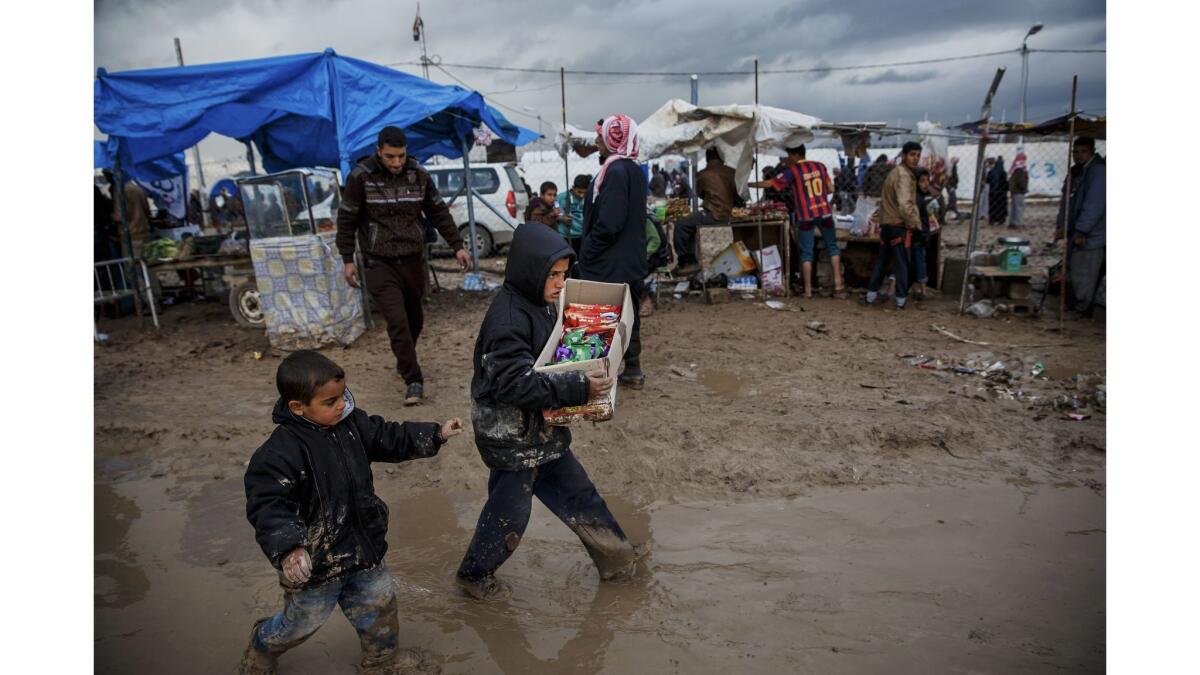
- Share via
Reporting from Hamam Alil, Iraq — They camp on muddy corners, beside an abandoned mosque and in the rain-soaked ruins of a soccer stadium — families displaced by ongoing fighting in Mosul are filling emergency camps in this smaller city about 20 miles south.
Disabled boys arrived in wheelchairs one day last week, and elderly men limped in on metal braces and canes.
Ashraf Mohammed Nouri came clutching his wide-eyed, 11-month-old daughter, Manara. Most of their family, including Manara’s mother, had been killed when their house was struck during fighting in west Mosul a week earlier, Nouri said. His mother had been hospitalized on the city’s east side.
“We don’t know what happened to her,” Nouri said of his mother as he awaited security screening at the camp entrance. “I just want to go and see my family.”
An estimated 400,000 Iraqi civilians remain trapped in Mosul’s western Old City as fighting intensifies and people continue to flee, United Nations officials warned.
“The worst is yet to come,” said Bruno Geddo, the United Nations High Commissioner for Refugees’ Iraq representative.
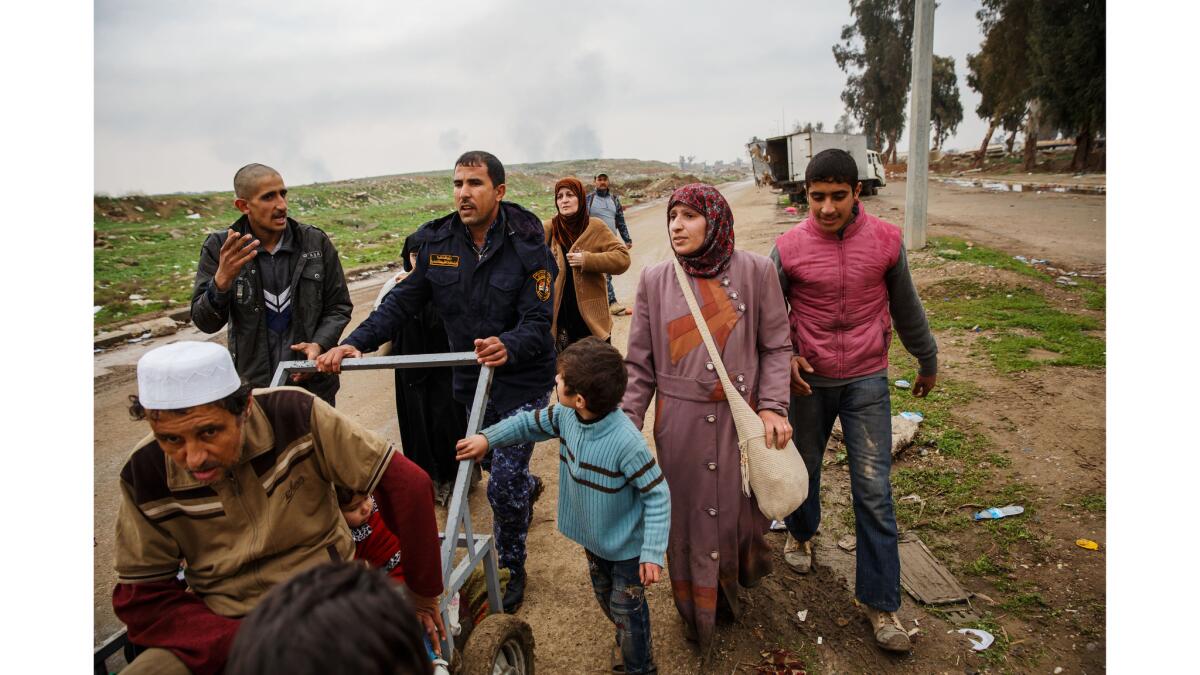
Meeting with civilians at the UNHCR camp at Hamam Alil, Geddo said the number of people moving through has “surged” in recent days with up to 12,000 arriving daily.
At least 340,000 people have been displaced since the fighting in Mosul started last October, and up to 500,000 could flee by the time it’s over, according to Iraqi and United Nations officials.
“Liberating Mosul is necessary but not sufficient,” Geddo said. “We equally have to get it right with the protection of civilians and in the humanitarian response.”
Aid agencies warned at the start of the Mosul offensive that hundreds of thousands could flee the fighting. Instead, many families on the east side initially sheltered in place, and those who did flee found shelter at hastily erected emergency camps.
Now, however, with fighting intensifying as troops move deeper into the more densely populated west side, shortages abound and the exodus has accelerated, with some arriving barefoot and bereft, straining Hamam Alil.
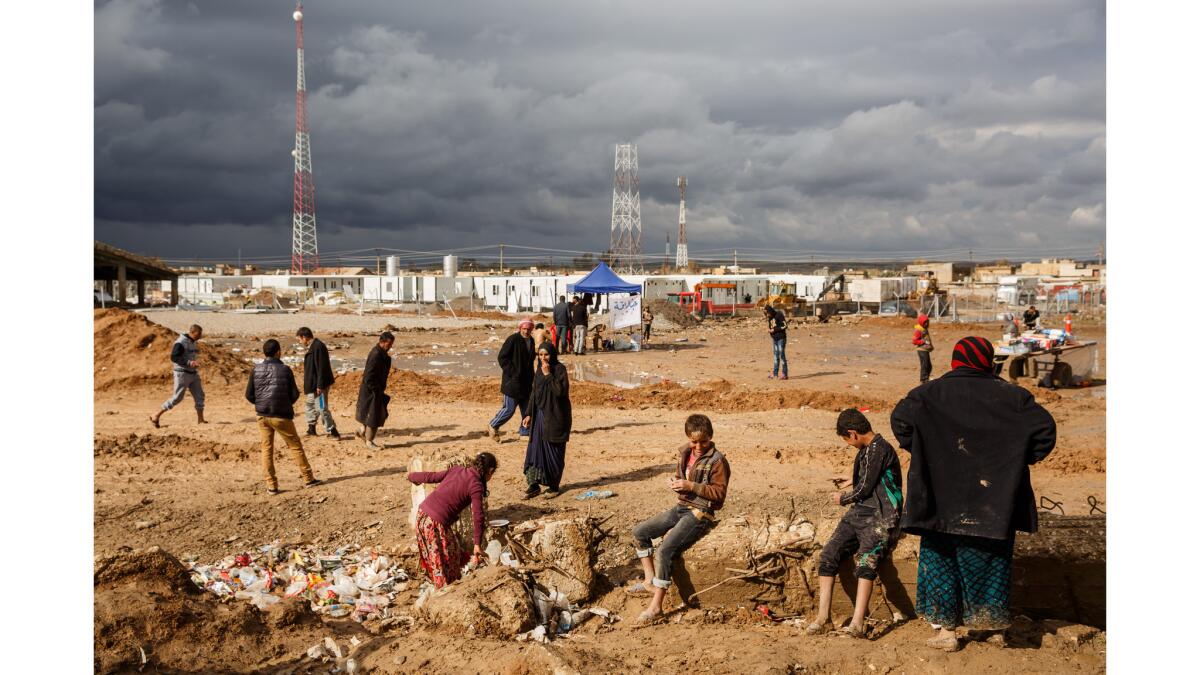
After more than 200 civilians were killed in what witnesses described as an airstrike, the U.S.-led coalition opened an investigation last week into whether it was responsible, and U.N. officials expressed concern for the welfare of civilians trapped in the city. The top U.S. general commanding the fight against Islamic State in the region this week said that the coalition was probably responsible for the strike.
“Nothing in this conflict is more important than protecting civilians,” said Lise Grande, the U.N.’s humanitarian coordinator for Iraq. “Parties to the conflict — all parties — are obliged to do everything possible to protect civilians. This means that combatants cannot use people as human shields and cannot imperil lives through indiscriminate use of firepower. We fear for the families who are caught in the conflict.”
The camp in Hamam Alil, like many surrounding Mosul, was quickly erected to provide the bare essentials: a fence for security, shelter under hundreds of white family tents, larger group tents designed to hold 150 people temporarily, and latrines, all lined up along dirt roads that quickly turn to mud when it rains.
Two weeks ago, 45,000 west Mosul residents were displaced, a 22% increase from the previous week, according to the U.N.
Last week, 215,306 displaced people were housed at 22 camps and emergency sites in the Mosul area, with an additional eight sites under construction, according to figures from the U.N., Institute of Migration and camp managers. Eight of those camps were full, including Hamam Alil, which housed 30,000.
And those figures don’t include thousands of others who passed through Hamam Alil earlier this month to other locations or stayed at informal settlements outside the camps, like the ruins of a mosque and soccer stadium.
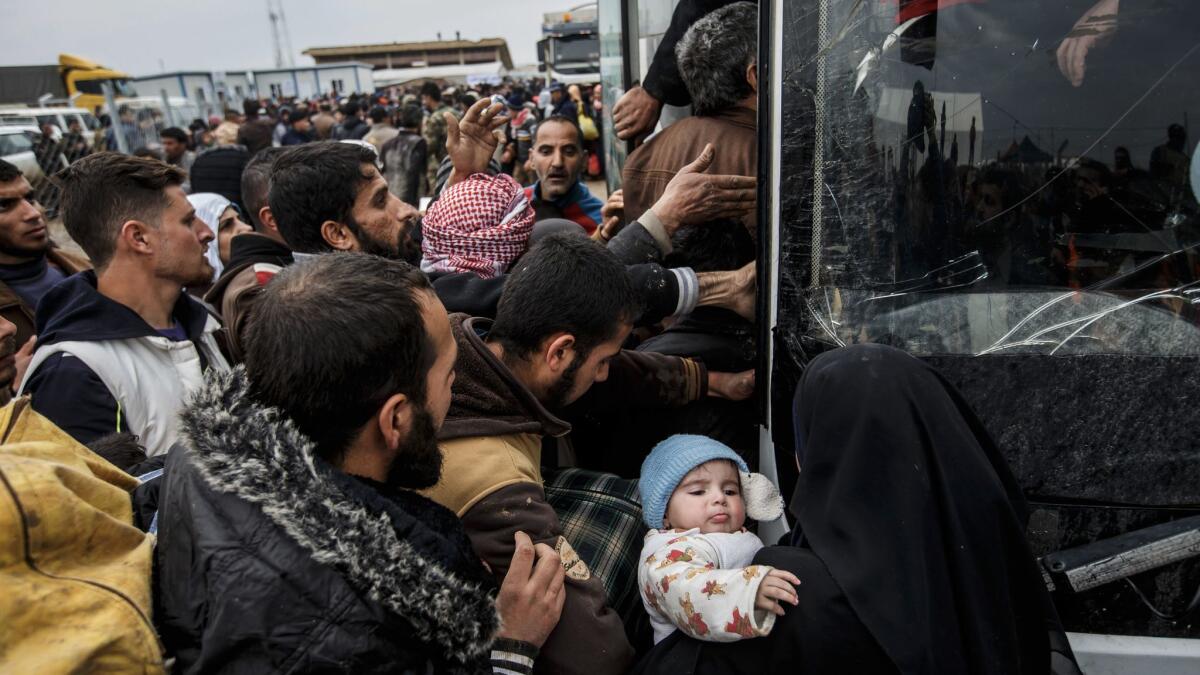
“There are tents waiting,” said Heidi Diedrich, Iraq country director for the Norwegian Refugee Council, which runs the camp in Hamam Alil and has increased aid in recent weeks along with other nonprofits. “Although many people are choosing to stay elsewhere, we are also trying to meet the needs of these people.”
Melany Markham, a spokeswoman for the Norwegian Refugee Council, was at the camp Thursday, and spoke with some of those settled just outside its gates.
“It’s complicated because all of the people who are displaced make their own decisions,” she said later. “For example, I met a 12-year-old boy and they have a lot of livestock, which they can’t have in the camp. So they’re staying by the mosque.”
There are other reasons why displaced families may wait to be housed at the same camp, she said: “There are ethnic and religious groups, or neighbors, who just want to say together.”
After Abdul Hadi Mohammed, 52, hobbled out of west Mosul with his Sunni family last week, his right leg injured by shrapnel from a mortar round, he was treated at a clinic in Hamam Alil but then chose to leave in an attempt to rejoin relatives at a camp in east Mosul.
He arrived to find Kurdish soldiers steering him to a different camp. Mohammed balked. His family ended up stuck at a military checkpoint. “We don’t know if there is space or not,” Mohammed said as he waited on crutches by the side of the road.
The Iraqi government revised its estimate of those expected to be displaced from western Mosul from 250,000 to 400,000, and expects the daily rate of displacement to exceed 10,000. Prime Minister Haider Abadi announced new initiatives to address the crisis, including increases in personnel, transportation, ambulances, camp support, aid to cleared areas and funding for the Iraqi Red Crescent.
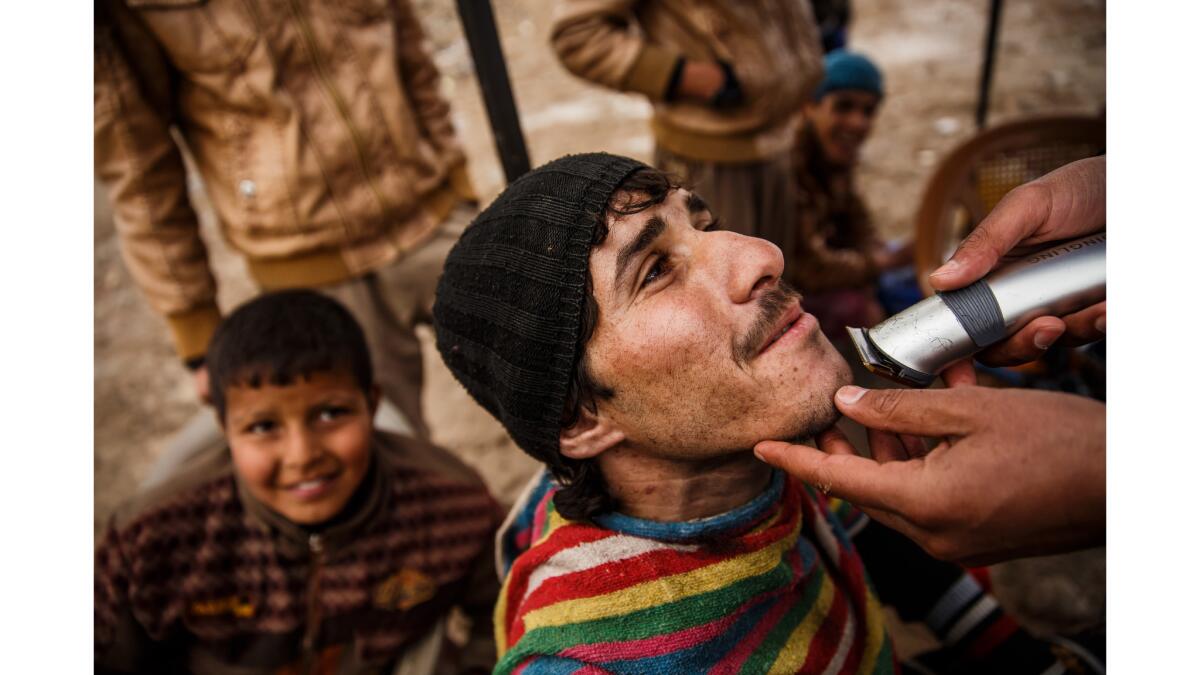
An extension of the Hamam Alil camp under construction nearby is expected to open in a week, doubling its capacity, Markham said. New camp construction around Mosul is expected to create shelter for nearly 276,000 additional displaced people.
Outside one of scores of tents at the Hamam Alil camp housing 150 people each, Ghanim Mohammed said he barely managed to flee west Mosul this month with his two children.
“We were in the crossfire between Islamic State and the [Iraqi] army. It was a miracle that we escaped,” he said.
Mohammed, 26, a laborer, wasn’t sure where they would go next, since their home was destroyed by mortar rounds. He was grateful for his spot in the tent, near a World Health Organization mobile clinic, portable bathrooms and food distribution. He knows other families squatting in the ruins of nearby buildings, which have not been fully cleared of bombs planted by militants.
Mohammed and camp staff pointed to a building where a family had been staying this month. They accidentally triggered a bomb and died.
Just up the street, 38 displaced people — including more than a dozen children — camped under the concrete ruins of the soccer stadium stands. They arrived the day before, cordoned off an area the size of two rooms with rope, bedsheets and comforters, then covered the ground with cardboard boxes.
“We feel secure in the area because police are around and they are protecting us,” said Samir Taha Tahsin, 42, although police had not told him about the dangers of hidden explosives.
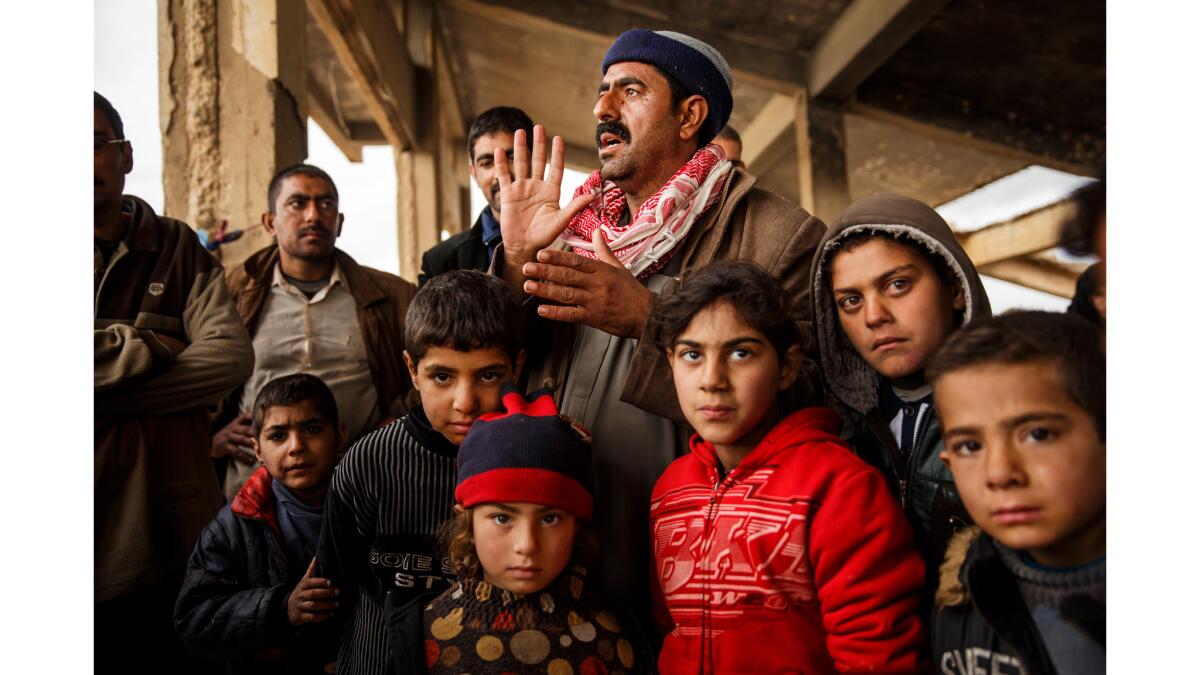
He and other farmers in his group planned to rent cars and leave soon, once they replaced identification paperwork they lost in Mosul that will help them clear security checkpoints. Islamic State militants had forced them into the city almost two years ago from their native Samarra to the south, they said, then from neighborhood to neighborhood. They still have land and want to return home.
They were receiving food from the camp next door, using the bathrooms and clinic. They worried others fleeing in coming days would receive even less than they have.
“Many families are still in Mosul. Many neighborhoods have not been freed yet. If they come here, where are they going to stay?” Tahsin said.
Twitter: @mollyhf
ALSO
Trump administration stops disclosing troop deployments in Iraq and Syria
Iraqi forces close in on historic mosque where Islamic State declared its ‘caliphate’
More to Read
Sign up for Essential California
The most important California stories and recommendations in your inbox every morning.
You may occasionally receive promotional content from the Los Angeles Times.











